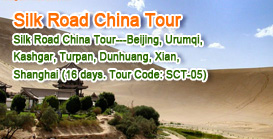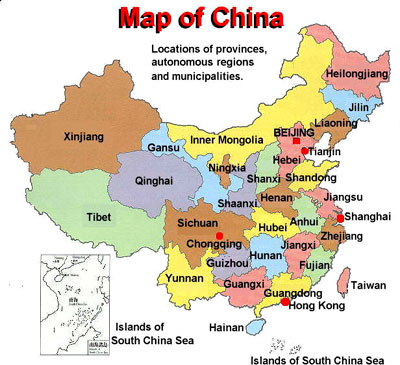Successchinatours.com offers discount China tour,China tours,China travel,travel agency China
2) Talk to our specialist
3) Our specialist gives a customized itinerary
4) Finalize the itinerary and price
5) Deposit is required for booking
6) Full payment before tour start
7) Service Voucher & Feedback
Getting China travel visa in Australia
Getting China travel visa in Canada
Getting China travel visa in New Zealand
Getting China travel visa in the UK
Getting China travel visa in the US
|
Time Zones |
Natural Resources
|
History |
Population |
Religion
|
Language | |
The vast territory of China stretches north and south for approximately 5,500km (about 50 latitudinal degrees) from the central line (53?31'N) of the Heilongjiang River at Mohe Town in Heilongjiang Province to the Tsengmu Reef (4?15'N) in the southernmost part of the South China Sea Islands; and east and west for 5,000 km (about 62 longitudinal degrees) from the confluence of the Heilongjuang and Wusulijiang rivers (135?5'E) to the Pamirs(73?40'E) in Xinjiang. China's geographical position in esastern Asia and on the western shore of the Pacific enables it to maintain close ties with landlocked neighbours in the west and reach out to countries across the sea. The abundance of rainfalls precipitated by moist air currents from the sea is a major source of freshwater essential to agricultural development in this country. The coastal regions provide ample space for maritime undertakings.
As the Tropic of Cancer runs across the southern part of China, which belongs to the Northern Hemisphere, the lion's share of the Chinese territory finds itself in the northern temperate zone, and a small part of it is in the tropical zone. A wide latitudinal span has endowed China with oenty of sunshine and solar energy, and this is conducive to the growth of a good variety of animals and plants.
Covering an area of 9.6 million square km, which is approximately one-fifteenth of the earth's land area or about the same size as Europe, China s the world's third largest country behind Russia and Canada.
|
|
Land Frontier: China's land frontier is about 20,000 km in length, extending from the Yalu River estuary on the Sino-Korean boundary to the Beicang River estuary on the Sino-Vietnamese boundary. The country is bounded by Korea ti the east; Russia to the northeast; Mongolia ti the north; Russia and Kazakhstan to the northwest; Kyrgyzstan, Tajikistan, Afghanistan and Pakistan to the west; India, Nepal, Sikkim and Bhutan to the southwest; and Myanmar, Laos and Viet Nam to the south.
Coastline: China's 18,000-km-long continental coast is washed by the Bohai Sea, the Yellow Sea, the East China Sea and the South China Sea.. The Pacific is off the eastern shore of the Taiwan Island.
There are more than 5,000 islands of varying sizes on the Chinese territorial seas, the largest of them being the Taiwan Island, and the second largest, The Hainan Island. Nine-tenths of these islands are found on the East China Sea and the South China Sea. There are also a number of archipelagos on the ocean, such as the Zhoushan Archipelago and the Nansha Archipelago.Shandong, Liaodong, and Leizhou are three largest peninsulas.
The Chinese territorial seas are 12 nautical miles in width. The Bohai Sea in the arms of the Liaodong and Shandong peninsulas, and the Qiongzhou Strait between the Leizhou Peninsula and the Hainan Island are continental seas.
The countries separated from China by the sea are, from north to south, the Republic of Korea, Japan, the Philippines, Brunei, Malaysia and Indonesia.
The physical relief of China drops off in a series of escarpments eastward to the sea, letting in humid air currents from the sea and causing many rivers to flow east. China's rivers amount to 220,000 km in total length. The Yangtze and Huanghe (Yellow) are among the world's mightiest rivers. Other renowned rivers include the Heilongjiang, Songhuajiang, Pearl, Liaohe, Haihe, Huaihe, Lancangjiang, Nujiang, Yarlung Zangbo, and Tarim.
The many-splendid land of China is glorified by far-reaching mountain chains, magnificent highlands, boundless plains, mountain-rimmed basins, and gentle rolling hille. Mountains and highlands make up 65% of the Chinese continent, which is studded with 2,000 odd natural lakes. The 8,848-metre-high Mount Qomolangma is the highest peak in the world; the lowest part of the Turpan Basin is 154 metres below sea level.
Four major highlands; Qinghai-Tibet Plateau, Inner Mongolia Plateau, Loess Plateau, and Yunnan-Guizhou Plateau.
Four major basins: Tarim, Junggar, Qaidam, and Sichuan.
Three major plains: Northeast China, North China, and the Middle and Lower Yangtze River.
China lies mainly in the northern temperate zone under the influence of monsoon. From September and October to March and April next year monsoon blows from Siberia and the Mongolian Plateau into China and decreases in force as it goes southward, causing dry and cold winter in the country and a temperature difference of 40 degrees centigrade between the north and the south. The temperature in China in the winter is 5 to 18 degrees centigrade lower than that in other countries on the same latitude in winter. Monsoon blows into China from the ocean in summer, bringing with them warm and wet currents, thus rain. Great differences in climate are found from region to region owing to China's extensive territory and complex topography. The northern part of Heilongjiang Province in the northeast has long winter but no summer, while Hainan Island in the south has a long summer but no winter. The Huaihe River valley features four distinct seasons, and the western part of the Qinghai-Tibet Plateau is covered by snow all year round. The southern part of the Yunan-Guizhou Plateau is spring-like in all seasons; and the northwestern inland regions could see great variations of temperature within the day. Annual precipitation also varies greatly from region to region, which is as high as 1,500 millimeters along the southeastern coast, and as low as 50 millimeters in the northwest.
The climate in Asia varies considerably from region to region. Kindly refer to our temperature guide below for seasonal averages. (Degrees in Fahrenheit)
|
City
|
Jan
|
Feb
|
Mar
|
Apr
|
May
|
Jun
|
Jul
|
Aug
|
Sep
|
Oct
|
Nov
|
Dec
|
| Beijing |
28
|
32
|
40
|
60
|
75
|
78
|
80
|
76
|
68
|
55
|
40
|
36
|
| Bangkok |
80
|
80
|
81
|
81
|
82
|
82
|
85
|
85
|
83
|
81
|
80
|
80
|
| Chengdu |
45
|
50
|
58
|
67
|
73
|
78
|
84
|
86
|
77
|
66
|
57
|
51
|
| Chongqing |
47
|
50
|
58
|
67
|
73
|
78
|
84
|
86
|
77
|
66
|
57
|
51
|
| Guangzhou |
58
|
60
|
69
|
70
|
80
|
83
|
83
|
81
|
78
|
70
|
60
|
57
|
| Guiyang |
37
|
42
|
53
|
63
|
71
|
72
|
76
|
77
|
68
|
57
|
53
|
47
|
| Ho Chi Minh |
79
|
80
|
80
|
81
|
82
|
85
|
85
|
88
|
86
|
82
|
80
|
80
|
| Hong Kong |
55
|
57
|
64
|
71
|
78
|
81
|
83
|
83
|
81
|
75
|
68
|
59
|
| Kunming |
50
|
52
|
58
|
65
|
68
|
68
|
70
|
67
|
65
|
62
|
55
|
50
|
| Lhasa |
29
|
34
|
41
|
46
|
54
|
60
|
61
|
60
|
57
|
48
|
39
|
32
|
| Seoul |
26
|
26
|
38
|
52
|
62
|
71
|
77
|
79
|
69
|
56
|
42
|
29
|
| Shanghai |
40
|
42
|
50
|
65
|
72
|
80
|
82
|
80
|
75
|
62
|
50
|
42
|
| Singapore |
79
|
79
|
80
|
82
|
82
|
84
|
85
|
85
|
85
|
82
|
81
|
80
|
| Wuhan |
37
|
41
|
50
|
61
|
70
|
80
|
84
|
83
|
75
|
64
|
53
|
42
|
| Xi'an |
32
|
38
|
50
|
56
|
72
|
80
|
78
|
76
|
60
|
52
|
40
|
30
|
|
City
|
Jan
|
Feb
|
Mar
|
Apr
|
May
|
Jun
|
Jul
|
Aug
|
Sep
|
Oct
|
Nov
|
Dec
|
Time Zones:
With a 60-degree longitudinal span, the territory of China covers five eastern (5th-9th) time zones according to the world time zoning practice. For convenience's sake, the country uses a uniform clock time - that of Beijing, which belongs to the 8th Eastern Time zone.
World Time
Zones
(When Beijing is at Noontime)
|
Multifarious weather conditions have endowed China with an abundance of flora and fauna resources, and that is why most of the farm crops, plants and wildlife in the world can be found in this country.
No country is so teeming with wildlife as China, home to more than 2,000 species of terrestrial vertebrates, 1,189 species of birds, 500 species of beasts, 210 species of amphibians, and 320 species of reptiles. Many animals are indigenous to China, such as giant panda, golden-haired monkey, unicorn taken, white-lipped deer (Cervus albirostris), and Chinese alligator.
China also boasts more than 32,000species of higher plants. Metasequoia, Cathaya argyrophylla, Pseudolarix amabilis, Eucommia ulmoides, and Fokienia hodginsii are indigenous trees in China. Hence China's nickname, 'World Treasury of Trees'. Some of the country's oldest trees have made a name for themselves for their close association with Chinese history. A cypress 20 metres in height and 10 metres in maximum girth in the Yellow Emperor's Temple in Huangling County, Shaanxi Province, is reputedly the nation's king of cypresses. The Zhou-dynasty cypress in the Jinci Temple in Taiyuan, Shanxi Province, is more than 3,000 years in age. China is also lauded as the 'Mother of World Horticulture' for a good variety of exotic flowers it has developed, such as peony, plum, winter jasmine and azalea.
More than 700 nature reserves have been established across the country to protect and preserve the native animals and plants, especially the endangered species. By June 1998, a total of 14 nature reserves - the Changbai Mountains, Mount Wuyi, Shennongjia, Fanjing Mountain, Dinghu Hill, Xilin Gol, Bogda, Fenglin, Yancheng, Xishuangbanna, Maolan, Wolong, Tianmu Mountain, and Jiuzhaigou Gully - had become part of UNESCO's Man and Biosphere Program.
With abundant natural resource, China is a world power in natural resource, the third largest country of the world, third in the world in the total value of verified deposits of mineral resources, fourth in the world in farmland acreage, and sixth in forest acreage. Its rivers rank sixth in total annual runoffs.
Another basic fact about China is that despite its immense natural resource aggregates, it is resource-poor on a per-capita basis, considering its huge population.
One of the world's oldest civilizations, China boasts a chronicled history of more than 5,000 years.
In the 21st century BC China saw the end of long years of primitive society and the beginning of the slave society with the founding of the Xia Dynasty. The Xia was followed by the Shang and Western Zhou dynasties. Then came the Eastern Zhou, which encompassed the Spring and Autumn and Warring States periods.
In 221 BC, Qinshihuang founded the Qin Dynasty, the first feudal autocracy in Chinese history that unveiled more than 2,000 years of feudalism which, until its demise in the Opium War of 1840, saw the rise and fall of a succession of dynasties like the Han, Tang, Song, Yuan, Ming and Qing.
The Chinese civilization reached an apex early in ancient times. As early as the Shang 3,000 years ago, the Chinese had invented the art of bronze metallurgy and iron tools. A galaxy of distinguished thinkers, scientists, artists and writers emerged in the intervening years. The Chinese of ancient times were known for their brilliant achievements in mathematics, medical science, astronomy, agriculture, architecture, and many other fields. The world never looked the same after the Chinese came up with the four major inventions: papermaking, mobile block printing, powder and the compass.
The bourgeois democratic revolution of 1911 led by Dr Sun Yat-sen toppled the rule of the Qing Dynasty, terminating more than two millennia's feudal monarchy, and culminating in the establishment of the provisional government of the Republic of China.
October 1, 1949 saw the founding of the People's republic of China. Today, in transition to a socialist market economic system under the policy of reform and opening up to the rest of the world, China is blazing a new trail in building socialism the Chinese way.
China, as the world's most populous nation, has a population of over 1.2 billion, or 22 percent of the global total.
Out of every five persons living in this word, one is a Chinese. East China has the highest population density, and this is especially so in coastal plains, where there are 500-600 residents per square km. West China has the lowest population density, averaging no more than 50 residents per square km. More than 300 million Chinese live in urban areas, and more than 800 million are rural residents. Planned parenthood has been a state policy since the 1970s, with a view to keeping the population in size and increasing its quality.
Religion:
China is a poly-religious country, where Taoism, Buddhism, Islamism, Christianity and Catholicism have all developed quite a following. Each ethnic group has its own habits and customs, and believes in one religion or another. For instance, about ten ethnic peoples, including the Huis and Uygurs, are Muslims. Most Tibetans believe in Lamaism, a branch of Buddhism, which is also followed by some Mongols. Freedom of religious belief is a government policy, and the Constitution protects normal religious activities.
|
Ethnic people in China enjoy the freedom to use and develop their own languages. Chinese is the universal language in this country; it is also one of the five working languages of the United Nations. Due to historical and geographical reasons, the Chinese language consists of quite a few local dialects, such as Suzhou, Cantonese, and Fukienese dialects. Putonghua is the standard spoken language for the Han people. The Chinese characters, which are the written form of the Chinese language, had their origin in oracle inscriptions more than 6,000 years ago. Most of the 55 ethnic minorities, however, speak their own languages, and some 30 of them have their own written languages.
Chinese family names came into being during the clan society some 5,000 years ago. There are more than 5,000 family names altogether, but only 300 or so are common. Zhang, Wang, Li, Zhao and Liu are most populous names. The name of a person generally consists of two or three Chinese characters, and the family name always comes before the given name. For example, the family name of a person called Zhang Siying is Zhang. Chinese forms of address are more or less the same as the Western. A man is addressed as xiansheng, or mister - such as Mister Li. An unmarried woman is addressed as xiaojie, or miss. A married woman retains her maiden name and she may be addressed as either Miss or Mrs. What's-Her-Name.
China is currently under a three-tiered administrative system - province, county (city) and township. Firstly, the entire country is divided into provinces, autonomous regions, municipalities and special administrative regions. Secondly, a province (or autonomous region) is divided into prefectures (autonomous prefectures), counties (autonomous counties), and cities. Thirdly, a county (autonomous county included) is divided into townships (ethnic autonomous townships, where necessary) and towns. Ethnic autonomy is practiced in autonomous regions, prefectures and counties where ethnic people live in compact communities.
Directly under the central government are 23 provinces, 5 autonomous regions, 4 municipalities, and 2 special administrative regions.
Beijing is the capital of the People's Republic of China and the nation's political, economic and cultural center.
Business License Number: 110102013192628 Postal Code: 100052
International Travel Service Permit Number: L – BJ00877
Address: Room 601 Building B, Fuzhuo Tower, No. 28 Xuan Wai Street, Xuanwu District, Beijing, China
Telephone: 86-10-8306 5275
E-mail: info@successchinatours.com
Design: http://www.dongyun01.com
京ICP备06068537





